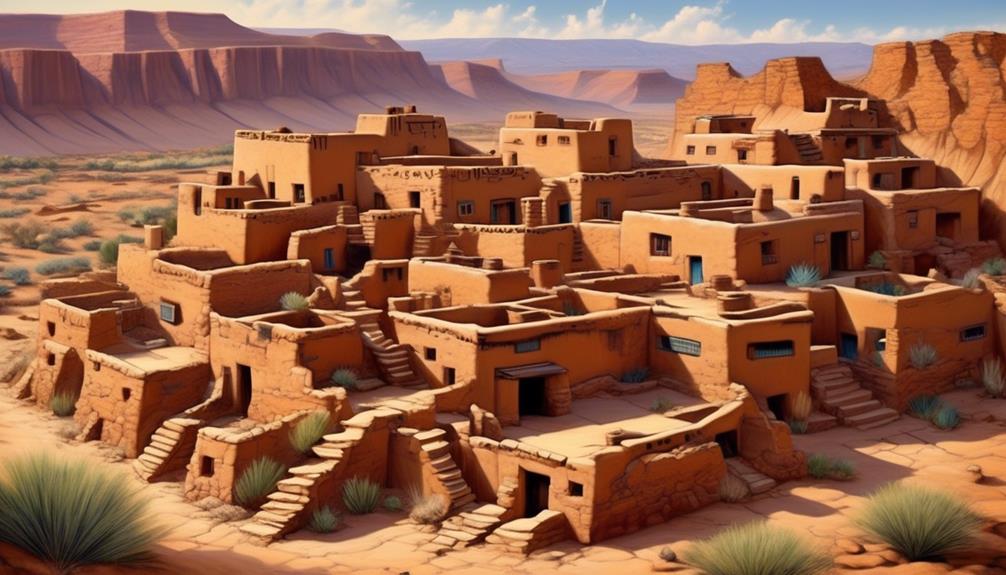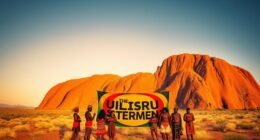When contemplating the wide range of Native American cultures, one cannot overlook the powerful connections between tribes that have impacted the Southwest region of the United States.
The Hopi Tribe and Zuni, known for their distinct traditions and customs, were part of a larger network of indigenous peoples that inhabited the area.
As we explore the intricate web of relationships between these tribes, we begin to uncover the fascinating connections that reveal the depth of their shared history and heritage.
Key Takeaways
- The Hopi Tribe and Zuni are both included in the tribes that descended from the Ancestral Puebloans.
- The Hopi Tribe has a deep-rooted connection to their ancestral lands.
- The Zuni have a rich pottery tradition that reflects their cultural continuity.
- The Hopi and Zuni tribes were influenced by the Sinagua people through settlements and trade networks.
Ancestral Puebloans
The Ancestral Puebloans were an ancient Native American civilization that inhabited the Four Corners region of the United States, known for their impressive stone masonry and cliff dwellings. The Hopi migration, a significant event in the history of the Ancestral Puebloans, played a crucial role in shaping the cultural landscape of the region. The Hopi people, believed to be the descendants of the Ancestral Puebloans, have a deep-rooted connection to the ancient sites and ruins left behind by their ancestors. Their reverence for these ancestral lands underscores the enduring legacy of the Ancestral Puebloans in the cultural fabric of the Hopi tribe.
Furthermore, the Zuni pottery traditions bear testimony to the artistic and technological prowess of the Ancestral Puebloans. The intricate pottery designs and techniques passed down through generations reflect the cultural continuity between the Ancestral Puebloans and the Zuni people. The preservation of these traditions serves as a tangible link to the rich heritage of the Ancestral Puebloans and their enduring influence on contemporary indigenous cultures in the region.
Mogollon Culture

Evidently, archaeological evidence attests to the complex societal organization and advanced agricultural practices of the Mogollon culture in the ancient Southwest. The Mogollon people were renowned for their distinctive pottery techniques, characterized by intricate designs and expert craftsmanship. This artistry not only served utilitarian purposes but also held significant cultural and symbolic meanings, reflecting the sophistication of Mogollon society.
- Mogollon Pottery Techniques
- Mogollon pottery was distinguished by its exceptional craftsmanship, intricate designs, and distinctive use of materials, showcasing the artistic and technical prowess of the Mogollon people.
- The pottery wasn't only utilitarian but also reflected the cultural and spiritual beliefs of the Mogollon, providing valuable insights into their societal values and practices.
- Trade Networks of the Mogollon Culture
- The Mogollon culture was interconnected through extensive trade networks, facilitating the exchange of goods, ideas, and cultural practices across the Southwest.
- Trade routes allowed for the circulation of resources and commodities, contributing to the economic prosperity and cultural diversity of the Mogollon society.
The remarkable pottery techniques and extensive trade networks exemplify the ingenuity and interconnectedness of the Mogollon culture, leaving a lasting impact on the ancient Southwest.
Hohokam Civilization
Archaeological evidence of the advanced agricultural practices and interconnectedness of the Mogollon culture provides valuable context for understanding the Hohokam Civilization in the ancient Southwest.
The Hohokam people, who inhabited the Sonoran Desert from around 1 AD to 1450 AD, are renowned for their sophisticated irrigation systems and extensive agricultural practices. The Hohokam's mastery of irrigation allowed them to flourish in an arid environment, cultivating crops such as maize, beans, and squash. Their intricate canal networks effectively managed water flow, enabling agricultural productivity on an impressive scale.
Moreover, the Hohokam Civilization was characterized by extensive trade networks and cultural exchange. Evidence suggests that the Hohokam engaged in trade with neighboring cultures, exchanging goods and ideas. This facilitated the transmission of knowledge and technologies, contributing to the cultural and economic prosperity of the region. The Hohokam's participation in trade networks also fostered connections with distant societies, enriching their cultural practices and belief systems.
Understanding the Hohokam Civilization in the context of their remarkable irrigation systems, agricultural practices, trade networks, and cultural exchange provides valuable insights into the complexity and sophistication of ancient Southwest societies.
Sinagua People

In studying the ancient Southwest, we encounter the Sinagua People, who inhabited the region from approximately 500 AD to 1425 AD, leaving behind a rich archaeological legacy. The Sinagua people are a fascinating ancient culture that thrived in the arid landscapes of present-day Arizona.
Here are some captivating aspects of the Sinagua people:
- Advanced Agricultural Practices:
The Sinagua people were adept at cultivating crops in the challenging desert environment, utilizing irrigation techniques to grow maize, beans, and squash.
- Influence on Hopi and Zuni Relations:
The Sinagua people played a significant role in the cultural and trade interactions between the Hopi and Zuni tribes. Their settlements and trade networks were integral to the exchange of goods and ideas between these neighboring tribes.
The Sinagua people's enigmatic cliff dwellings, intricate pottery, and their enigmatic disappearance from the region continue to spark scholarly debates and captivate the imagination of those interested in the ancient cultures of the American Southwest.
Ancient Sonoran Desert People
The ancient Sonoran Desert people developed sophisticated farming techniques to thrive in the harsh desert environment, contributing to the rich tapestry of cultures in the American Southwest.
Their agricultural practices were integral to their survival, with innovations such as the use of canals for irrigation and the cultivation of maize, beans, and squash.
These practices not only sustained their own communities but also allowed for the development of trade networks with neighboring tribes.
Through these trade networks, the ancient Sonoran Desert people exchanged goods, ideas, and technologies, further enriching the cultural landscape of the region.
The interconnectedness facilitated by these trade routes is evident in the spread of distinct pottery styles and other artifacts across the Southwest.
The exchange of agricultural knowledge also played a pivotal role in the development and prosperity of various indigenous communities.
Understanding the agricultural practices and trade networks of the ancient Sonoran Desert people provides valuable insights into their resilience, adaptability, and contributions to the broader indigenous societies of the American Southwest.
Frequently Asked Questions
How Did the Hopi Tribe and Zuni Interact With Other Neighboring Tribes?
We observed that the Hopi Tribe and Zuni had intricate inter-tribal relations, characterized by cultural exchange. They interacted with neighboring tribes through trade, alliances, and ceremonial collaborations.
These interactions facilitated the exchange of knowledge, traditions, and resources, fostering a rich tapestry of cultural diversity. The respectful and collaborative nature of their engagements with other tribes exemplified the interconnectedness and mutual respect within the broader indigenous community.
What Were the Religious Beliefs and Practices of the Hopi and Zuni Tribes?
Religious beliefs and ceremonial practices of the Hopi and Zuni tribes are deeply rooted in their cultural traditions. Their social structure and historical influence have shaped their environmental adaptation and current status.
The neighboring interactions and tribal contributions have forged a spiritual connection. It's fascinating to explore how these beliefs and practices have evolved over time, reflecting the resilience and richness of their heritage.
What Were the Major Contributions of the Hopi and Zuni Tribes to the Ancestral Puebloans, Mogollon Culture, Hohokam Civilization, Sinagua People, and Ancient Sonoran Desert People?
We can explore the major contributions of the Hopi and Zuni tribes to the Ancestral Puebloans, Mogollon culture, Hohokam civilization, Sinagua people, and ancient Sonoran Desert people.
These contributions encompass various aspects, such as cultural exchange, architectural techniques, agricultural practices, and artistic expressions.
Investigating these connections can shed light on the interconnectedness of these ancient societies and how they collectively navigated environmental challenges.
Understanding their contributions can also provide insights into their current status and enduring legacies.
How Did the Hopi and Zuni Tribes Adapt to the Environmental Challenges of the Region?
We've found that the Hopi and Zuni tribes showed remarkable resilience in adapting to the environmental challenges of the region.
Their adaptation strategies, deeply rooted in cultural practices, are a testament to their ability to thrive in a challenging environment.
Through tribal interactions and unique cultural practices, they haven't only sustained themselves but have also contributed valuable knowledge and practices to other cultures.
Their current status reflects their enduring strength and adaptability.
What Is the Current Status of the Hopi and Zuni Tribes and Their Cultural Traditions?
Currently, the Hopi and Zuni tribes are actively engaged in preserving their cultural traditions through educational initiatives and community engagement.
They're focusing on economic development while maintaining their current traditions.
Both tribes are dedicated to sustaining their cultural heritage amidst modern challenges, ensuring that their unique customs and beliefs continue to thrive for future generations.
Conclusion
In conclusion, the tribes included in the Hopi and Zuni cultures have left a rich and complex legacy that continues to shape the Southwest region. These tribes include the Ancestral Puebloans, Mogollon Culture, Hohokam Civilization, Sinagua People, and Ancient Sonoran Desert People.
Their traditions, art, and spiritual beliefs have endured through the ages, providing a deep connection to the land and a profound understanding of their place in the world.









